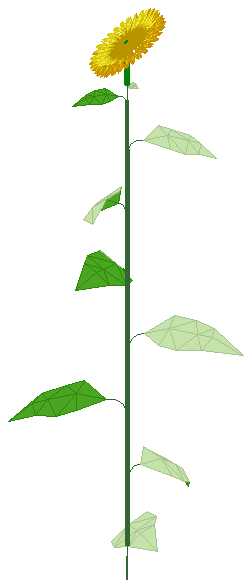 https://www.kurtz-fernhout.com/PlantStudio/
https://www.kurtz-fernhout.com/PlantStudio/
see Plant Studio© Web site for downloading to Windows systems,
requirements, and help. (This lesson can also be done at the Illinois
State Museum's Research & Collections Center in Springfield, where
the Technology Learning Center, Herbarium, and Prairie Garden are located.
Phone the technology Learning Center for information.)
Objective:
Students will be able to identify by name the parts of plants and the relationships
among these parts as they use Plant Studio Freeware Wizard and tools on the
computer to draw a particular plant from life or from a picture. They will
understand how the anatomy and appearance of plants vary with the size and
shape and color differences among the same set of parameters. They will also
be able to describe how generations of plants may vary in appearance as the
parameters vary by using the breeding tool of the freeware. They will be able
to tweak their drawings by editing the parameters. They can artistically pose
their plants using the posing tool.
Grades:
4th and up, adjusting the number and depth of parameters when editing
Time Required: time in garden or acquiring pictures plus one
hour on the computer
Motivation:
Computer graphics and science are used together in science, art, and museum
careers. Science students who do not consider themselves artists can use these
graphics tools to study, illustrate reports, make diagrams, and create landscape
elements. It is important for scientists and illustrators to know the names
of plant parts and their relationships to one another in order to understand
how plants grow and reproduce. Software designers have created a freeware
program for botanists and graphic designers called Plant Studio. This program
allows users to create a digital plant in a Wizard by making choices about
how plant parts should look, for example, by using a photograph of a plant
and making choices of parameters by eye. It also has a tool for breeding generations
of plants to show how different parameters become dominant. Users can tweak
the parameters of the plant individually to correct the wizard, and they can
pose the plant before exporting or printing it for use elsewhere.
Materials:
Plant Studio© Freeware for Windows - see their Web site for requirements:
https://www.kurtz-fernhout.com/PlantStudio/requirements.htm
computer (PC)
p Printer (optional)
Vocabulary:
Flower
Pistil
Stamen
Sepal
Bud
Bract
Primary, Secondary Inflorescence
Fruit
Root top
Meristem - cell groups that grow into a leaf on a stem or another branch
Internode - stem
Leaf
Seedling leaf
Monocot
Dicot
Parameter
Pose
Procedure:
- Outdoors if possible: examine the plants in a garden to identify the parts
of plants (listed above) and how the many species of plants differ in appearance
although they are made up of the same parts. Students note that the size,
length, color, and number of plant parts create
- Use actual plants as models for the Plant Studio modeling if possible.
If this is impossible, each student should have a photograph of a plant
specimen.
- Students will open Plant Studio Freeware and be led through its tools
briefly (parameters will be used to edit, breed (in top, pull down PLANT
menu) is another tool, pose is used to edit, age lets one view an animation
of plant growth.)
- Students will start the Plant Wizard; teacher leads students through their
choices; results are displayed. Discuss whether the result is an accurate
portrayal of the model plant. (as choices are often short, medium, long,
for example, rather than direct measurements, plants may display legginess
or compactness compared to the model.)
- Editing begins by using the parameters screen on the right. If internodes
are too short, they can be lengthened; if petals are too large, they can
be decreased in size, etc.
- After editing, plants can be posed to rotate to the best-looking side
or hidden branches can be rotated to show.
- When plant is satisfactory, SAVE on disk and/or print out.
- To BREED plant, click on the PLANT item in the top menu and choose BREED.
A screen will open and a new generation of variants will appear. Breeding
variation (the blue flower icons below the top menu on this screen) can
be adjusted from none to high). Discuss which parameters of the parent plant
are dominant in each offspring and why that happens. Select any offspring
and click on BREED again, etc.
Assessment:
- Students will use their vocabulary of plant part names to describe the plant
they created. (10 points or fewer)
- Students will produce a plant that is recognizable
as the species of the model plant. (10 points or fewer) (To edit their initial
Wizard result successfully, they will have to negotiate the terms in the parameters.)
- Students will increase their proficiency from novice to beginner or intermediate
with the software.
Illinois
State Board of Education Goals: Science:
Late Elementary:
12.A.2a Describe simple life cycles of plants and animals and the
similarities and differences in their offspring.
12.A.2b Categorize features as either inherited [or learned (e.g.,
flower color or eye color is inherited; language is learned)].
13.B.2a Explain how technology is used in science for a variety
of purposes (e.g., sample collection, storage and treatment; measurement;
data collection, storage and retrieval; communication of information).
13.B.2b Describe the effects on society of scientific and technological
innovations (e.g., antibiotics, steam engine, digital computer).

